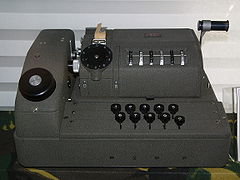
C-52 (cipher machine)
Encyclopedia

Crypto AG
Crypto AG is a Swiss company specialising in communications and information security. With headquarters in steinhausen, the company is a long-established manufacturer of encryption machines and a wide variety of cipher devices...
starting 1951/1952. These pin-and-lug type cipher machines were advanced successors of the C-38/M-209
M-209
In cryptography, the M-209, designated CSP-1500 by the Navy is a portable, mechanical cipher machine used by the US military primarily in World War II, though it remained in active use through the Korean War...
. The machine measures 8 1/2in × 5 3/8in × 4 3/8in. The device is mechanical, but when combined with an electric keyboard attachment, the B-52, the resultant system is termed the BC-52. The B-52 is larger, measuring 12 1/2in × 8 1/2in × 6 3/8in.
Both C and CX models are equipped with six pinwheels. In the C-52 version, these six wheels are chosen from a possible set of 12, with the number of pins on each wheel being 25, 26, 29, 31, 34, 37, 38, 41, 42, 43, 46, and 47. The C model had a fixed stepping system with a large wheel cycle due to the prime numbers of the six wheels. http://www.deathstar.ch/security/encryption/history/images/CX-52_01.jpg. The CX-52 version has 6 pinwheels with 47 pins each and a flexible wheel movement system. The lug cage of both models contains 32 movable bars: 27 of the bars are used for encryption and the remaining 5 bars control the stepping of the pinwheels. The early CX models used the control bars also for encryption but due to complications in creating acceptable lug settings later CX models used these bars only for controlling of the wheel stepping. The stepping of the CX wheels was controlled by adjustable lugs on the control bars.
The C-52 and CX-52 were very flexible machines that could be produced in various ways, creating a unique machine with unique cryptographic characteristics for each customer. There were special detachable wheel movement bars and their position on the drum could change, interchangeable print wheels, custom pinwheel labels, versions with One-time Tape reader instead of wheels http://www.jproc.ca/crypto/cx52.html, versions that only enciphered numbers, and many other details that influenced the enciphering process.

External links
- Technical details of the C-52 and CX-52 Encryption principle and machine variations, by Dirk Rijmenants
- Dirk Rijmenants' Hagelin BC-52 Simulator
- The HAGELIN cryptographer CX-52 by Torbjorn Andersson — a write-up, photograph and a QBASICQBasicQBasic is an IDE and interpreter for a variant of the BASIC programming language which is based on QuickBASIC. Code entered into the IDE is compiled to an intermediate form, and this intermediate form is immediately interpreted on demand within the IDE. It can run under nearly all versions of DOS...
simulator. - Jerry Proc's page on the CX-52 — also covers the B-52 keyboard unit.
- Photographs: http://home.ca.inter.net/~hagelin/C52-1.jpg, http://home.ca.inter.net/~hagelin/C52-2.jpg, http://www.deathstar.ch/security/encryption/history/images/CX-52_01.jpg, http://www.apprendre-en-ligne.net/crypto/instruments/cx52.jpg, http://www.eclipse.net/~dhamer/images/A143082_022As.JPG, http://www.homeworlds.com/crypto/Cipher_Machines_Pictures.html
- Jerry Proc's page on the Hell 54 — a licensed copy of the C-52 by Hell
- Descriptions from sales of C-52 and CX-52 equipment
- CX-52 Cryptographic Machine & B-52 Motorized Base

